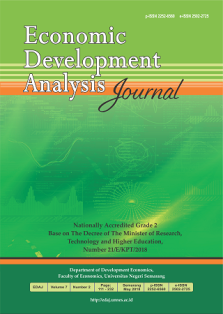Testing of the Phillips Curve in Indonesia
Abstract
This study aims to determine how the results of Phillips theory testing in 34 provinces in Indonesia based on the main sectors contributing to the GRDP. The analytical method used in this study is Product Moment correlation analysis to determine the relationship between the inflation rate variable and the unemployment rate variable. The data used in this study are data on open unemployment and inflation rates taken in 34 provinces in Indonesia from 2014-2018. The results of this study indicate there is no Phillips curve pattern in 34 provinces in Indonesia. The inflation rate variable and the unemployment rate variable in 34 provinces in Indonesia based on the main sectors contributing to the GRDP have a positive but very weak relationship with a correlation value of 0.1089. The problem of price volatility (inflation) contributes, although not significantly to the emergence of the unemployment problem. Government policies are needed to control inflation and reduce unemployment rates such as fuel subsidies, corporate tax reductions, export tax reductions, and control of raw material prices considering that the results of this study indicate that rising inflation will be followed by an increase in unemployment.


